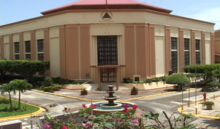Anastasio Somoza Debayle
Anastasio "Tachito" Somoza Debayle (Spanish: [anasˈtasjo soˈmosa ðeˈβajle]; 5 December 1925 – 17 September 1980) was the 53rd President of Nicaragua from 1967 to 1972 and again from 1974 to 1979.
One of his classmates was Pedro Joaquín Chamorro Cardenal,[2] who later became a journalist and publisher of La Prensa newspaper and one of the most prominent opponents of the Somoza dynasty.
He and older brother Luis Somoza Debayle both attended St. Leo College Prep (Florida) and La Salle Military Academy on Long Island.
Somoza attended La Salle with Lt. Andrew Edward Tuck III, uncle of American television host Stephen Colbert, and would stay at the family home in Larchmont during the holidays instead of returning to Nicaragua.
[3] Somoza Debayle passed the examination for West Point, entered the United States Military Academy on July 3, 1943, and graduated on June 6, 1946.
The president had also appointed numerous family members and close personal friends to other important posts in his government.
As commander of the Guard, the young Somoza was head of the nation's armed forces, effectively the second-most powerful man in Nicaragua.
Anastasio also had a large hand in the government during this time; he helped ensure that the presidency was held by politicians loyal to his family from 1963 to 1967.
The company collected blood plasma from up to 1,000 of Nicaragua's poorest persons every day for sale in the United States and Europe.
According to El Diario Nuevo and La Prensa, "Every morning the homeless, drunks, and poor people went to sell half a liter of blood for 35 (Nicaraguan) cordobas.
[10] On 23 December 1972, an earthquake struck the nation's capital, Managua, killing about 5,000 people and virtually destroying the city.
He reportedly embezzled a large amount of money from funds sent to Nicaragua from around the world to help rebuild Managua.
[13] In 1975 Somoza Debayle launched a campaign to crush the Sandinistas; individuals suspected of supporting the Front were targeted.
The Front, named after Augusto César Sandino (a Nicaraguan rebel leader in the 1920s), began its guerrilla war against the Somozas in 1963.
At this point, the opposition to the Somozas included not only Sandinistas, but other prominent figures such as publisher Pedro Chamorro (assassinated on January 10, 1978).
[16] Denied asylum in the U.S. by President Carter, Somoza later took refuge in Paraguay, then under the rule of Alfredo Stroessner.
The leader was Argentinian Marxist revolutionary Enrique Gorriarán Merlo (code named "Ramon"), an ex-Ejército Revolucionario del Pueblo member.
The commando team also utilized disinformation tactics to gain access into important residencies under the guise of a famous name, that being Julio Iglesias.
Team member Oswaldo, disguised as a paper boy, watched Somoza exit the estate and signaled when he was leaving at 10:10 am.
Previously, the commando team had considered the possibility that Somoza's vehicle might be equipped with armor panels in front.
Fidel and his brother Raúl Castro purportedly developed a complex, multinational covert action to provide the Sandinistas with huge quantities of modern armaments.
He says that Somoza was a long-time nemesis of Castro after having provided critical support to the U.S. in preparing for the Bay of Pigs Invasion of Cuba in April 1961.
[22] Jorge Masetti, a former Argentine guerrilla working with Cuban intelligence services, describes the Somoza assassination and also asserts that Cuba had a direct role in planning it in his memoir, In the Pirate's Den (2002).
The same year, he was depicted in Under Fire, set during the 1979 Nicaraguan Revolution, this time portrayed by actor René Enriquez.



